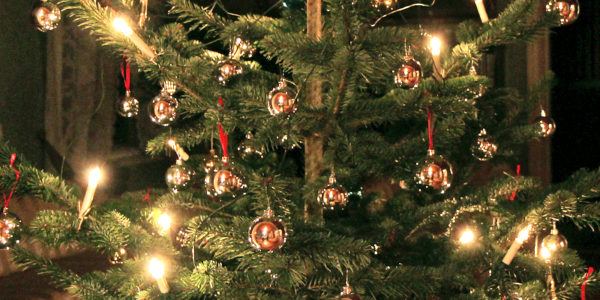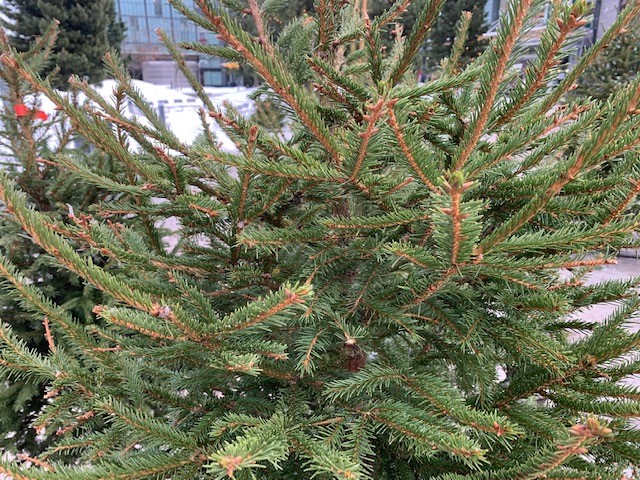Your Christmas tree may host thousands of critters – some may become active in room temperature

The diversity of nature in your home and outside it is a wonderful thing, says Carita Lindstedt-Kareksela from the University of Helsinki.
At Christmas, many Finnish homes are visited by both Father Christmas and members of the extended family, but some unexpected visitors also arrive with the Christmas tree. Carita Lindstedt-Kareksela, Associate Professor of Forest Entomology at the University of Helsinki and an Academy of Finland Research Fellow, estimates that there may be several thousand living creatures in one Christmas tree.
Forest entomology is a discipline that studies insects living in forests.
Among the species that sneak in with the tree, Lindstedt-Kareksela first mentions the small spiders that spend the winter in young spruces. In room temperature, they may become active ’actually quite rapidly’.
Insects that winter in spruces can be found among the needles, on the trunk or in the cones. A fairly common species is the spruce carpet (Thera variata), a moth whose larvae spend the winter among the needles.
Another, though somewhat rarer, species that may be found among the spruce branches is the Calliteara abietis. In Finland, this moth is mainly found in the south.
At the base of spruce buds you may find nymphs (immature forms) of the Sacchiphantes abietis bug. If the tree is mature enough to have produced cones, you may encounter the moth Dioryctria abietella.

’In addition, the surface of the spruce trunk hosts many kinds of microbes, such as fungi and bacteria, which may actually have been useful to the spruce, helping it to fight against disease or insects that feed on it,’ Lindstedt-Kareksela says.
Telltale signs in the spruce may reveal the presence of certain organisms.
’Of the fungi that grow on spruce, the human eye can detect at least the rust fungi, as they produce an orange stain on the needles. Older spruces may carry various species of lichen, which make good hiding places for mites, spiders, springtails, thrips and barklice.’
Insects may hatch indoors
Will the Christmas tree become a hive of activity during the holidays? Lindstedt-Kareksela explains that the end of an insect’s dormancy, or diapause, is often a complicated process. Room temperature alone may not be enough for insect eggs to hatch, for some species also require a certain number of daylight hours.
Sometimes, however, the wintering eggs or larvae of an insect may hatch indoors, if temperatures have been cold enough during early winter.
Apart from living things, the tree may also contain organisms that are no longer alive.
If you take a magnifying glass to check the needles, you may find insects and spiders that willow tits or their relatives have stashed away for the winter.
’If you take a magnifying glass to check the needles, you may find insects and spiders that willow tits or their relatives have stashed away for the winter,’ Lindstedt-Kareksela says.
’Spruces are also an important source of food for squirrels, but I wouldn’t say that they often come all the way into the house with the tree,’ Lindstedt-Kareksela says.
Ending up indoors is unlucky for all these organisms. If an insect or spider wakes up in the middle of winter in your living room, it will not find enough food anywhere in the house, or a suitable environment for reproduction.
Biodiversity is reflected in the number of organisms
Lindstedt-Kareksela says that the total number of organisms living on or in a spruce, as far as insects and spiders are concerned, can vary between dozens or thousands, depending on the kind of forest the spruce comes from, as well as on its age and size.
’If you also add all the microbes, the number will increase quite a lot. There’s nothing to stop you from making an inventory of the insects in your spruce with a magnifying glass, needle by needle. That could actually be a fun and relaxing holiday project for the whole family,’ Lindstedt-Kareksela suggests.
Cultivated spruces sport less activity than forest-grown ones
Lindstedt-Kareksela says that spruces felled in a forest contain more organisms than spruces from a Christmas tree plantation. This is due to biodiversity, and that is affected by the intensity of commercial use of the forest, its age structure, the presence of deadwood and a deadwood continuum, as well as the size of the forest and its closeness to other forests.
A more diverse forest will also have more food and suitable environments for the several species that prey or parasitize on insects. Diversity can also prevent forest damage.
’Species that destroy forest trees often favour trees of a particular species and age. A stand that contains just one tree species and is even-aged can be more vulnerable to a pest that favours that species, compared to a more heterogeneous forest,’ Lindstedt-Kareksela explains.
However, there is no need to fear any of the tiny creatures hiding in the Christmas tree.
’The diversity of nature and being able to observe it, whether in your own house or somewhere out of doors, is a wonderful thing, and none of the organisms brought home with a Finnish spruce cause any harm to humans”, Lindstedt-Kareksela assures.